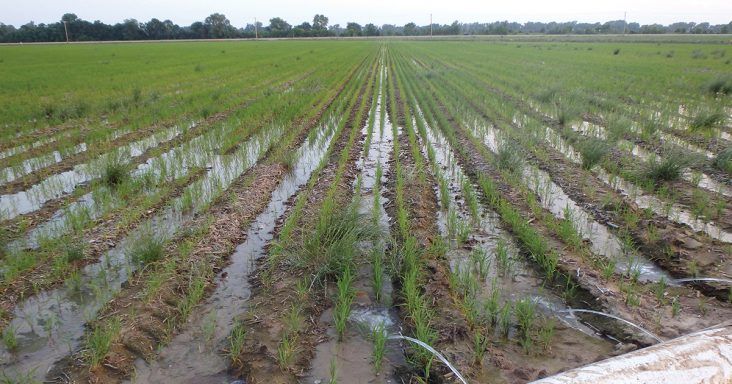Row rice gaining in popularity in Arkansas
by March 12, 2019 8:43 am 6,319 views

Photo courtesy of UA System Division of Agriculture.
William Fuller went on a hunting trip in 1896 with a friend to Louisiana and little did the Arkansas farmer know that the trip would turn him into a “king” and transform his state forever. While he was on the trip, he noticed farmers growing rice, the most consumed grain in the world.
Rice was first introduced in the southern U.S. in South Carolina in 1694, according to historians. Slowly, the crop made its way across the south. Fuller noted that the soil in Louisiana was similar to soils found in the Arkansas Delta Region. It took him nearly a decade to perfect a technique for growing rice in the Natural State, but when he was finished it was a game changer. Arkansas would go on to become the largest rice producing state in the country, growing roughly half the nation’s rice a century later, and Fuller is known as the “King of Arkansas rice.”
Rice is typically grown in paddies, or fields inundated with water. Rice row crop farming, or furrow irrigated rice as it’s sometimes called, is becoming more and more popular, according to the University of Arkansas Agriculture Cooperative Extension Service. Two meetings detailing the emergence of row crop rice were held during the month of February in Jonesboro and Stuttgart.
“Row rice is an emerging production practice for rice that is increasing adoption, but lacks a consensus on production practices,” Chris Henry, associate professor and extension water management engineer with the University of Arkansas System Division of Agriculture said.
“Farmers are interested in furrow irrigated rice because of the potential to reduce tillage passes, plant earlier and explore the use of no-till and cover crops,” Henry said. “By sharing experiences, we hope to gather information that can be used to improve recommendations and direct research efforts and it’s an opportunity to learn from other farmers and consultants from across the region.”
Rice paddies have been common in the Delta for many years. During the 1980s farmers experimented with systems that allowed rice to be grown in standard rows, but those fields produced a lot of blast fungus, a disease that can damage or kill a rice plant, University of Arkansas Division of Agriculture rice agronomist Dr. Jarrod Hardke said. Science has been able to stem that trend, and rice rows have steadily grown in recent years. The number of rice row acres has jumped from 40,000 in 2017 to more than 100,000 acres in 2018, he said.
In a recent three-year study, funded by the Arkansas Rice Research and Promotion Board, Henry found that row rice used significantly less water than flooded rice using polypipe or multiple inlet rice irrigation and the yields were not significantly different.
“That really surprised us, because we expected higher water use numbers and less yield,” he said.
Row crop rice could mean more money in a farmer’s pocket, Hardke said. A typical rice acre has about $750 in input costs. Growing rice in rows can save a producer up to $70 per acre, per season, he said. Rice in rows can be grown in former soybean beds, meaning they don’t have to be prepped like typical rice paddies. This can save a farmer many hours on their combines and other equipment, Hardke said, adding that those fields don’t require the levee systems and are irrigated with pipes, much like other row crops.
Hybrid varieties of rice make the row system possible. About half of Arkansas’ rice acreage or 700,000 acres is hybrid, Hardke said. Hybrids can develop resistance to diseases such as blast fungus, but a hybrid blend can only be used for one growing season. Hybrids are produced when one part infertile male pollen and one fertile male pollen are combined to produce an offspring, he said. These hybrids tend to produce better yields and are more disease resistant, he said.
Saving $70 per rice acre could have a significant impact on the state’s economy.
According to the Arkansas Farm Bureau, the rice industry is the second largest agriculture sector in Arkansas, only trailing soybean production. Rice contributes billions of dollars to the state’s economy and creates about 25,000 jobs, AFB reported.
In 2018, Arkansas farmers grew 1.4 million rice acres, a 30% uptick from 2017 when about 1.161 million acres were planted. It was 47.1% of all rice acres planted in the U.S., according to the B.R. Wells Arkansas Rice Research.
Those acres accounted for 82.6 million hundredweight of rice and it represented 46.4% of the 178.2 million hundredweight produced in the country. During the last three years, Arkansas has accounted for more than 47% of the nation’s total rice production, the report found. Per acre, farmers had a yield of 164.4 bushels per acre or 7,400 pounds. It was the third highest yield on record in the state and a 570 pound per acre uptick from 2016.
Rice is grown in 40 of Arkansas’ 75 counties and is predominantly grown in the eastern section of the state. The rice growing region in the state starts with Clay County in Northeast Arkansas and extends southward to Chicot County in southern Arkansas. Traditionally, the top rice producing counties in the state are Lawrence, Poinsett, Jackson, Arkansas, and Lonoke, according to the United States Department of Agriculture.
